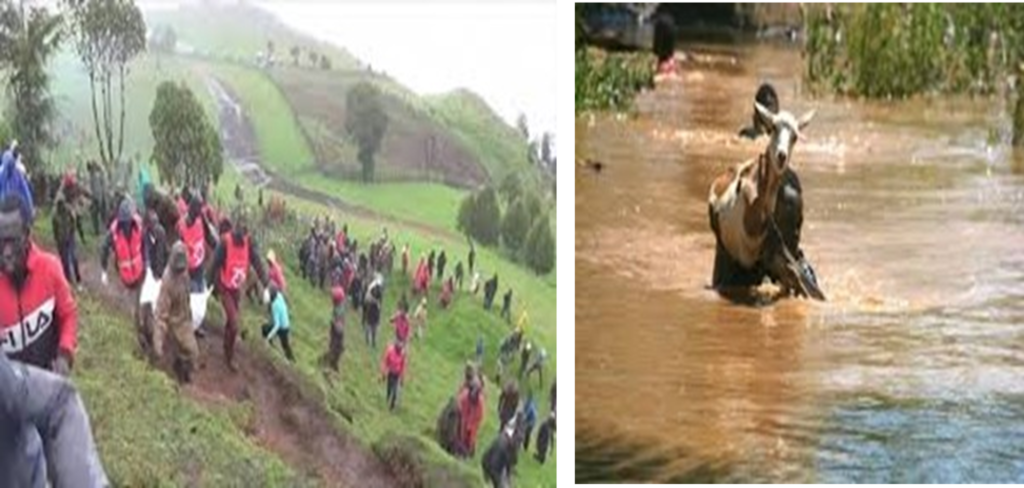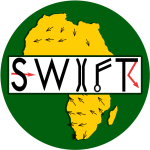Kenya Meteorological Department (KMD – the national operational weather service of Kenya) is one of a number of African organisations that has worked on producing new forecasting tools as a part of SWIFT. Through SWIFT, KMD has worked with research organisations and forecast users1 to make forecasting products that have already seen life-saving applications during recent weather-related events. Here we discuss the developments that have been made at KMD and the direct impacts they have already had.
Practical, economic and societal impact
Kenya has faced many severe weather-related issues in the last few years. Heavy rains were recorded in 2019 and 2020 where more than 160,000 people were affected including 72 who lost their lives in landslides2. A large locust swarm occurred in 2020, leading to significant loss of crop harvest. Other examples of extreme weather in Kenya include high winds and extreme waves. Reliable weather forecasting allows for a better response to severe weather. This could be for evacuation before an event occurs, or safer rescue and containment procedures after an event occurs.

Figure 1: Rescue and evacuations where at least 72 people were killed after heavy rainfall triggered a landslide in Pokot, Northwest Kenya in 2019 while a man tried to rescue his only goat from flood due to severe rainfall left and right panels respectively.
The Kenya Meteorological Department (KMD) has been active in incorporating SWIFT research and development into their forecasting operations and uses this to help facilitate responses to severe weather. SWIFT has helped to develop products in Kenya, for example by organising testbeds3 for nowcasting (0-6 hour forecasting) and seasonal to subseasonal (2-4 week) forecasting products, which can then be used operationally. Knowledge and innovation from SWIFT work has been shared through KMD: four forecasters from KMD work on the SWIFT project and then share knowledge with the other (approx.) 100 forecasters at KMD through mentoring, everyday engagement, and formal training events at KMD’s training school, IMTR (Institute for Meteorological Training and Research).
SWIFT has worked with the European Organisation for the Exploitation of Meteorological Satellites (EUMETSAT) to facilitate the use of EUMETSAT Nowcasting4 (NWCSAF) products in partner countries. This is now operational in Kenya and is used, for example, in daily severe weather reports issued by KMD and cascaded to seven other East African countries. Previously, KMD was using satellite tools only for a general overview of the weather situation: in particular, the conventional satellite data cannot be used to accurately locate where precipitation is falling. For this reason, KMD did not carry out any nowcasting. By introducing the nowcasting techniques, KMD are able to offer much more accurate forecasts on short timescales of a couple of hours.
The NWCSAF product has been incorporated into a new app called FASTA (Forecasting African Storms Application) which gives easily interpretable nowcasting forecasts and can be downloaded in Kenya for free. The product gives reliable information on severe storms, allowing people to respond effectively.
SWIFT has helped to facilitate the evaluation of forecasts produced by KMD using the NWCSAF product. Satellite data are used to verify whether predictions are correct, and this information is then used to produce statistics such as ‘hit rates’ (approximate probability that a weather event is correctly predicted) and ‘false alarm rates’ (approximate probability a weather event is not predicted) which are now disseminated with forecasts. This forecast evaluation is vital to improve services, and to justify to stakeholders that the services have skill and value.
KMD has also begun using new meteorological models developed by SWIFT partners. Thanks to the training and evaluation provided in SWIFT, convection-permitting models (modern models using very fine scale of prediction, down to a few km, that are particularly effective in Africa) and seasonal to subseasonal models are now being used operationally in KMD and are improving the accuracy of forecasts in Kenya. In particular, KMD is now using the “Tropical Africa model” provided by the UK Met Office, which is the highest-resolution operational weather prediction model currently available for the whole of tropical Africa. Evaluation of forecasts using the NWCSAF product has shown improvements in the effectiveness of forecasts since the beginning of SWIFT, and this can be partly attributed to the use of the new models.
By using the new models, KMD are now able to offer forecasts at a finer resolution. This has been used for example in Nairobi to inform people in informal settlements of heavy rainfall through the KDI-DARAJA (Kounkey Design Initiative – Developing Risk Awareness towards Joint Action) project, where the finer resolution was noted to be valuable.
The new products have had success in the response to heavy rains in recent years. As KMD forecasts are now more accurate and provide measures of reliability, authorities were more likely to act on forecasts. Forecasts are offered 2 days in advance of severe events and disseminated to disaster management authorities, national government, county governments, media and other risk management authorities. Based on these forecasts, decisions have been made for the safety of lives and property and to prompt people to take protective action. Nowcasting has also been used in rescue operations to know where efforts would be most effective. Users were able to contact KMD directly by phone, and the NWCSAF product facilitated an informed and immediate response.
KMD forecasts were effectively used in the response to locust swarms which reached the country in 2020. Locust populations breed to swarm levels when there is enough consecutive heavy rainfall (above 25mm) and are known to accumulate in areas of wind convergence. KMD supplied measures of wind and rainfall to authorities who used the information to concentrate extermination efforts at the most densely populated areas. Without SWIFT, this information would not have been used – the measures of reliability produced using the NWCSAF product were critical in forming the necessary trust to respond to predictions.
Because SWIFT has built capacity in Kenya, the innovation facilitated by SWIFT in Kenya is sustainable and will likely see more positive uses in future. Through knowledge sharing and training, information will be passed on and tools will be continually used moving forward. Products developed by SWIFT partners, such as the UK Met Office’s ‘Tropical Africa’ forecasting model now feature in KMD standard operating procedures (SOPs). When SOPs are revised in future, the NWCSAF product will feature prominently. The incorporation of the products into SOPs means that they will become a regular feature of operations at KMD.
Benefits of international and collaborative working
SWIFT has advanced the capacity of staff at KMD through international training and collaborations. This has contributed to the improvement of forecast products. For example, SWIFT has organised several programming workshops internationally for forecasters, using the python programming language. Python skills are critical in the analysis of data for forecast evaluation, which in turn is important when organisations are deciding whether to act on a forecast. Forecasters at KMD are already using python when producing longer term forecasts, such as on monthly and seasonal timescales.
By encouraging collaborations between users and forecast producers, SWIFT has built users’ trust in forecasts. Through the National Climate Outlook Forum, the forecast process is explained to stakeholders. Government secretaries have been shown around KMD to have a better understanding of new forecasting tools. When users have a clear idea of how forecasts work, they can make more informed decisions when confronted with a forecast.

Figure 2: Senior Kenya government officials let by Cabinet Secretary Dr. Fred Matiangi in charge of national security coordination of Kenya government ministries making high level decisions and policy statements based on the reliable heavy rainfall forecast advisory issued by KMD in 2019.
Links between operational and research services have also been strengthened through SWIFT: in Kenya this has meant the strengthening of the collaboration between KMD and the University of Nairobi, which is one of the top centres for meteorological research and training in Africa and is also a partner in SWIFT. Previously, forecasters were trained at the university and then moved to forecasting centres to work, with little collaboration otherwise. Since SWIFT, the operational and academic institutions have worked together more, such as on development of products and on updating the university curriculum to reflect the latest advances in forecasting. For example, lecturers at the university have developed training modules in nowcasting, and are delivering this training to cohorts of students every year. These links should be sustained in future.
Another benefit of collaborative working is that new developments have been shared beyond SWIFT. Three non-SWIFT forecasters have already engaged with SWIFT products during the third SWIFT testbed when developing new products – one from Jomo Kenyatta International Airport and two from KMD headquarters. They learned how to use the NWCSAF product and now use it operationally in their own forecasts. Through international working at KMD, SWIFT forecasters in KMD introduce new forecasting methods to professionals in other countries. In daily severe weather meetings, weather reports from KMD use SWIFT products, thus exposing forecasters in other countries to these products and their potential applications. The nowcasting training developed at University of Nairobi has been delivered to MSc students in neighbouring Rwanda through a partnership agreement
Some further uses of SWIFT products are easily attainable. In aviation, for example, the NWCSAF product will be used to improve nowcasting of severe weather, which needs to be regularly monitored at airports in case of dangerous flying conditions. KMD plans to share the product with users in this sector.
The advances made at KMD are a significant step. Many new forecast products developed through SWIFT, such as new models and nowcasting tools, are now in operation. The new forecast products have already had positive applications – they were an important tool in responses to recent heavy rains and locust swarms, and allowed authorities to take more coordinated action. When severe weather-related events reach Kenya in future the country will be able to use more accurate forecasts with clear measures of reliability to organise responses and save lives, both through early warning and disaster management.
Authors
Martin Parker, David Koros, Jemimah Gacheru, Siân Evans, Alan Blyth, Douglas Parker
Footnotes
[1] Users are people, groups and organisations that use weather forecasts. Examples include people living in areas that are susceptible to severe weather; farmers and agriculture organisations; governments and transport companies.
[2] https://reliefweb.int/disaster/fl-2019-000138-ken
[3] Testbeds are intensive forecast development projects where forecasts are made and then evaluated in real time. SWIFT brought together forecast researchers, producers and users to work on three separate testbeds.
[4] Nowcasting is the use of real-time data to provide immediate information on hazards, and to forecast the development of those hazards over the coming hours.
